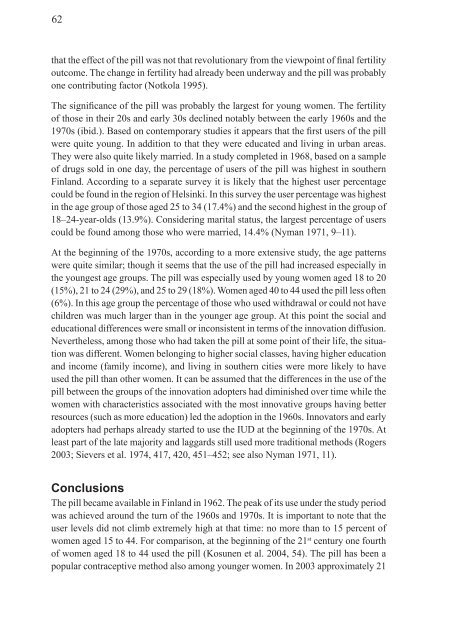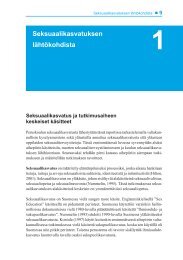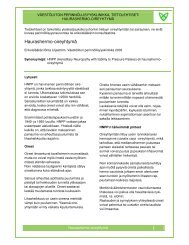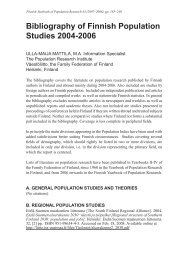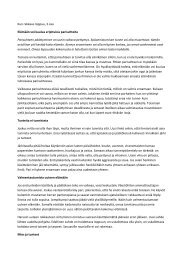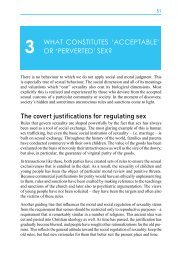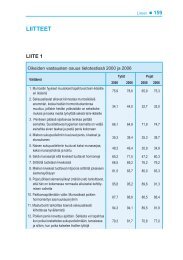Early History of the Oral Contraceptive Pill in Finland ... - Väestöliitto
Early History of the Oral Contraceptive Pill in Finland ... - Väestöliitto
Early History of the Oral Contraceptive Pill in Finland ... - Väestöliitto
You also want an ePaper? Increase the reach of your titles
YUMPU automatically turns print PDFs into web optimized ePapers that Google loves.
62<br />
that <strong>the</strong> effect <strong>of</strong> <strong>the</strong> pill was not that revolutionary from <strong>the</strong> viewpo<strong>in</strong>t <strong>of</strong> f<strong>in</strong>al fertility<br />
outcome. The change <strong>in</strong> fertility had already been underway and <strong>the</strong> pill was probably<br />
one contribut<strong>in</strong>g factor (Notkola 1995).<br />
The significance <strong>of</strong> <strong>the</strong> pill was probably <strong>the</strong> largest for young women. The fertility<br />
<strong>of</strong> those <strong>in</strong> <strong>the</strong>ir 20s and early 30s decl<strong>in</strong>ed notably between <strong>the</strong> early 1960s and <strong>the</strong><br />
1970s (ibid.). Based on contemporary studies it appears that <strong>the</strong> first users <strong>of</strong> <strong>the</strong> pill<br />
were quite young. In addition to that <strong>the</strong>y were educated and liv<strong>in</strong>g <strong>in</strong> urban areas.<br />
They were also quite likely married. In a study completed <strong>in</strong> 1968, based on a sample<br />
<strong>of</strong> drugs sold <strong>in</strong> one day, <strong>the</strong> percentage <strong>of</strong> users <strong>of</strong> <strong>the</strong> pill was highest <strong>in</strong> sou<strong>the</strong>rn<br />
F<strong>in</strong>land. Accord<strong>in</strong>g to a separate survey it is likely that <strong>the</strong> highest user percentage<br />
could be found <strong>in</strong> <strong>the</strong> region <strong>of</strong> Hels<strong>in</strong>ki. In this survey <strong>the</strong> user percentage was highest<br />
<strong>in</strong> <strong>the</strong> age group <strong>of</strong> those aged 25 to 34 (17.4%) and <strong>the</strong> second highest <strong>in</strong> <strong>the</strong> group <strong>of</strong><br />
18–24-year-olds (13.9%). Consider<strong>in</strong>g marital status, <strong>the</strong> largest percentage <strong>of</strong> users<br />
could be found among those who were married, 14.4% (Nyman 1971, 9–11).<br />
At <strong>the</strong> beg<strong>in</strong>n<strong>in</strong>g <strong>of</strong> <strong>the</strong> 1970s, accord<strong>in</strong>g to a more extensive study, <strong>the</strong> age patterns<br />
were quite similar; though it seems that <strong>the</strong> use <strong>of</strong> <strong>the</strong> pill had <strong>in</strong>creased especially <strong>in</strong><br />
<strong>the</strong> youngest age groups. The pill was especially used by young women aged 18 to 20<br />
(15%), 21 to 24 (29%), and 25 to 29 (18%). Women aged 40 to 44 used <strong>the</strong> pill less <strong>of</strong>ten<br />
(6%). In this age group <strong>the</strong> percentage <strong>of</strong> those who used withdrawal or could not have<br />
children was much larger than <strong>in</strong> <strong>the</strong> younger age group. At this po<strong>in</strong>t <strong>the</strong> social and<br />
educational differences were small or <strong>in</strong>consistent <strong>in</strong> terms <strong>of</strong> <strong>the</strong> <strong>in</strong>novation diffusion.<br />
Never<strong>the</strong>less, among those who had taken <strong>the</strong> pill at some po<strong>in</strong>t <strong>of</strong> <strong>the</strong>ir life, <strong>the</strong> situation<br />
was different. Women belong<strong>in</strong>g to higher social classes, hav<strong>in</strong>g higher education<br />
and <strong>in</strong>come (family <strong>in</strong>come), and liv<strong>in</strong>g <strong>in</strong> sou<strong>the</strong>rn cities were more likely to have<br />
used <strong>the</strong> pill than o<strong>the</strong>r women. It can be assumed that <strong>the</strong> differences <strong>in</strong> <strong>the</strong> use <strong>of</strong> <strong>the</strong><br />
pill between <strong>the</strong> groups <strong>of</strong> <strong>the</strong> <strong>in</strong>novation adopters had dim<strong>in</strong>ished over time while <strong>the</strong><br />
women with characteristics associated with <strong>the</strong> most <strong>in</strong>novative groups hav<strong>in</strong>g better<br />
resources (such as more education) led <strong>the</strong> adoption <strong>in</strong> <strong>the</strong> 1960s. Innovators and early<br />
adopters had perhaps already started to use <strong>the</strong> IUD at <strong>the</strong> beg<strong>in</strong>n<strong>in</strong>g <strong>of</strong> <strong>the</strong> 1970s. At<br />
least part <strong>of</strong> <strong>the</strong> late majority and laggards still used more traditional methods (Rogers<br />
2003; Sievers et al. 1974, 417, 420, 451–452; see also Nyman 1971, 11).<br />
Conclusions<br />
The pill became available <strong>in</strong> F<strong>in</strong>land <strong>in</strong> 1962. The peak <strong>of</strong> its use under <strong>the</strong> study period<br />
was achieved around <strong>the</strong> turn <strong>of</strong> <strong>the</strong> 1960s and 1970s. It is important to note that <strong>the</strong><br />
user levels did not climb extremely high at that time: no more than to 15 percent <strong>of</strong><br />
women aged 15 to 44. For comparison, at <strong>the</strong> beg<strong>in</strong>n<strong>in</strong>g <strong>of</strong> <strong>the</strong> 21 st century one fourth<br />
<strong>of</strong> women aged 18 to 44 used <strong>the</strong> pill (Kosunen et al. 2004, 54). The pill has been a<br />
popular contraceptive method also among younger women. In 2003 approximately 21


